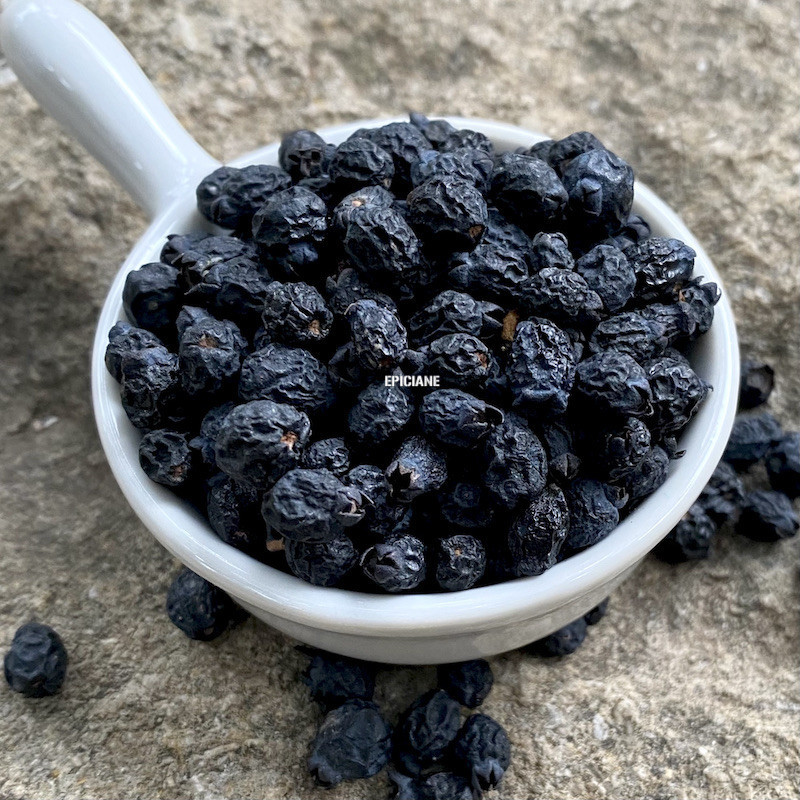- Out-of-Stock



Our myrtle berries, hand-picked in Provence, are both sweet and slightly tangy, with a very pleasant taste.
Primarily used for liqueurs, they are also delicious with game or in marinades.
 Delivery
Delivery
Mondial Relay
 Returns
Returns
See conditions
 Payments
Payments
100% secure
- Livré en sachet refermable -
Uses in Cooking and Beyond:
Both the leaves and berries of the myrtle shrub, and sometimes even its flowers, are used in cooking. The berries can enhance liqueurs and myrtle wines, as well as meats like game.
Simply add a few berries at the beginning of cooking to a meat stew, sautéed vegetables, roasted, stewed, or stuffed poultry, or to meat marinades, pâtés, or terrines. The berries also pair well with fish, whether baked or poached.
Today, the popularity of myrtle berries has led to many culinary innovations: myrtle berry-flavored teas, stuffed prunes, sauces for ice creams, nougat, and even mustard, all incorporating myrtle berries!
Here are two recipes to make your own myrtle wine (myrtéi in Corsican). The first starts with myrtle alcohol, followed by myrtle liqueur, and ultimately leads to myrtle wine. The second is a direct preparation of myrtle wine.
First Recipe:
This final recipe is done in three stages, but you can stop at the first or second, as each step has a unique flavor!
Incise 500g of fresh myrtle berries with the tip of a knife and macerate them in 2 liters of fruit alcohol for 1 month. Since these berries are dried, 300g is sufficient.
Then strain the liquid using a fine sieve, lightly pressing the fruits to extract as much juice as possible.
The resulting juice is quite dark, so I recommend filtering it through a paper filter before bottling. The alcohol is now ready!
Myrtle Liqueur:
Make a syrup with 300g of sugar and 300g of water, and mix it with the previous preparation. It's ready! This liqueur is best served very chilled, especially after a good meal.
Myrtle Wine:
In a 75cl bottle, pour one glass of the previously made myrtle liqueur and top it off with a good regional wine. Then, refrigerate.
Second Recipe:
In a large jar (like a demijohn), macerate the following ingredients for 45 days:
You can also add orange, cloves, etc. Let the mixture macerate in a cool, shady spot, stirring frequently. After 45 days, simply strain it and pour it into bottles with tight closures (such as screw caps). Fill the bottles to the brim and seal them carefully. Your myrtle wine can be kept for a year or longer. Its beautiful fuchsia pink color and strong taste will delight you. Serve it chilled, but remember to drink responsibly!
Myrtle berries and leaves are also widely used in cosmetics (especially the essential oil) for their concentration of oligo-galacturans, proteins that protect skin cells from aging by extending their lifespan. These anti-aging properties are remarkably similar to those of Helichrysum (immortelle), a neighboring plant in the maquis, though its essential oil is much rarer and more expensive.
Who am I?
Origin: France, Provence
Scientific name: Myrtus communis
In French, “le myrte” refers to the shrub, while “la myrte” refers to the berry or leaf—one of the many quirks of the French language!
The myrtle shrub belongs to the Myrtaceae family, growing no taller than 3 meters. It is widespread around the Mediterranean, especially in Corsica, where it abundantly populates the maquis. The shrub has evergreen foliage and fragrant white flowers that bloom in June and July. Its blue-violet berries, resembling juniper or blueberries, are harvested in the fall or early winter when they begin to shrivel. The berries are mainly used for making liqueurs, while the leaves are used as a seasoning for game. Pigs and wild boars that feed on myrtle develop a unique flavor in their meat, which has earned Corsican charcuterie its prestigious reputation.
The wood of the myrtle shrub, both hard and flexible, was once used to make baskets and fish traps. Today, it is more commonly used to flavor grilled meats!
A Little History:
Myrtle has long been associated with love and beauty. Corsican women traditionally used it to make a floral water called "Eau d'Ange," reputed to restore radiance to dull and tired skin.
The symbolic value of myrtle is such that it is often used as decoration for weddings and is sometimes paired with olive branches for Easter blessings.
In Jewish tradition, myrtle is one of the four plants used during the festival of Sukkot (the Feast of Tabernacles in September). In ancient Greece, myrtle was worn by priestesses and was the sacred plant of Aphrodite.
Interestingly, in the French Republican calendar, the 26th day of the month of Thermidor (corresponding to August 13) was named "Myrtle Day."
Data sheet
Reference: 3N7137901
Reference: vanillebourbonE
Reference: 408164502
Reference: ecorceorangeamere
Reference: ecorceorangeamere
Reference: ecorcecitronH
Reference: baieroseE
Reference: 10N7738802
Reference: punch
Reference: hypocras
Reference: 6N7456401
Reference: vinchaud
Reference: 2M6273801
Reference: vermouth
Reference: 20731803
Reference: 9N7669901
Reference: gentiane
Reference: 3N7137901
Reference: 2071570

Our myrtle berries, hand-picked in Provence, are both sweet and slightly tangy, with a very pleasant taste.
Primarily used for liqueurs, they are also delicious with game or in marinades.